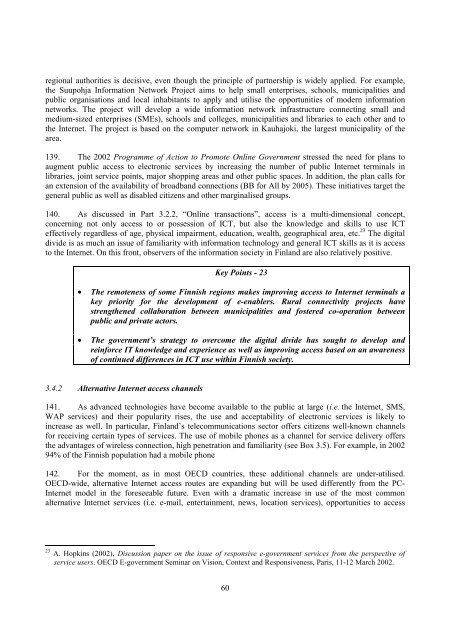e-GOVERNMENT IN FINLAND - ePractice.eu
e-GOVERNMENT IN FINLAND - ePractice.eu
e-GOVERNMENT IN FINLAND - ePractice.eu
You also want an ePaper? Increase the reach of your titles
YUMPU automatically turns print PDFs into web optimized ePapers that Google loves.
egional authorities is decisive, even though the principle of partnership is widely applied. For example,<br />
the Suupohja Information Network Project aims to help small enterprises, schools, municipalities and<br />
public organisations and local inhabitants to apply and utilise the opportunities of modern information<br />
networks. The project will develop a wide information network infrastructure connecting small and<br />
medium-sized enterprises (SMEs), schools and colleges, municipalities and libraries to each other and to<br />
the Internet. The project is based on the computer network in Kauhajoki, the largest municipality of the<br />
area.<br />
139. The 2002 Programme of Action to Promote Online Government stressed the need for plans to<br />
augment public access to electronic services by increasing the number of public Internet terminals in<br />
libraries, joint service points, major shopping areas and other public spaces. In addition, the plan calls for<br />
an extension of the availability of broadband connections (BB for All by 2005). These initiatives target the<br />
general public as well as disabled citizens and other marginalised groups.<br />
140. As discussed in Part 3.2.2, “Online transactions”, access is a multi-dimensional concept,<br />
concerning not only access to or possession of ICT, but also the knowledge and skills to use ICT<br />
effectively regardless of age, physical impairment, education, wealth, geographical area, etc. 23 The digital<br />
divide is as much an issue of familiarity with information technology and general ICT skills as it is access<br />
to the Internet. On this front, observers of the information society in Finland are also relatively positive.<br />
Key Points - 23<br />
x The remoteness of some Finnish regions makes improving access to Internet terminals a<br />
key priority for the development of e-enablers. Rural connectivity projects have<br />
strengthened collaboration between municipalities and fostered co-operation between<br />
public and private actors.<br />
x The government’s strategy to overcome the digital divide has sought to develop and<br />
reinforce IT knowledge and experience as well as improving access based on an awareness<br />
of continued differences in ICT use within Finnish society.<br />
3.4.2 Alternative Internet access channels<br />
141. As advanced technologies have become available to the public at large (i.e. the Internet, SMS,<br />
WAP services) and their popularity rises, the use and acceptability of electronic services is likely to<br />
increase as well. In particular, Finland’s telecommunications sector offers citizens well-known channels<br />
for receiving certain types of services. The use of mobile phones as a channel for service delivery offers<br />
the advantages of wireless connection, high penetration and familiarity (see Box 3.5). For example, in 2002<br />
94% of the Finnish population had a mobile phone<br />
142. For the moment, as in most OECD countries, these additional channels are under-utilised.<br />
OECD-wide, alternative Internet access routes are expanding but will be used differently from the PC-<br />
Internet model in the foreseeable future. Even with a dramatic increase in use of the most common<br />
alternative Internet services (i.e. e-mail, entertainment, news, location services), opportunities to access<br />
23 A. Hopkins (2002), Discussion paper on the issue of responsive e-government services from the perspective of<br />
service users. OECD E-government Seminar on Vision, Context and Responsiveness, Paris, 11-12 March 2002.<br />
60
















